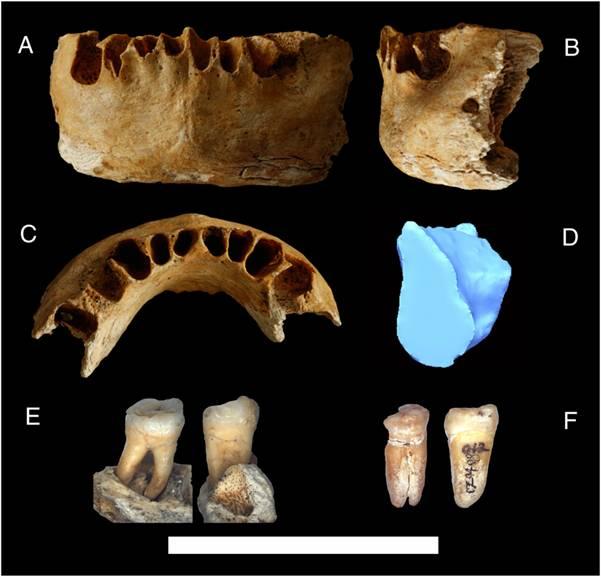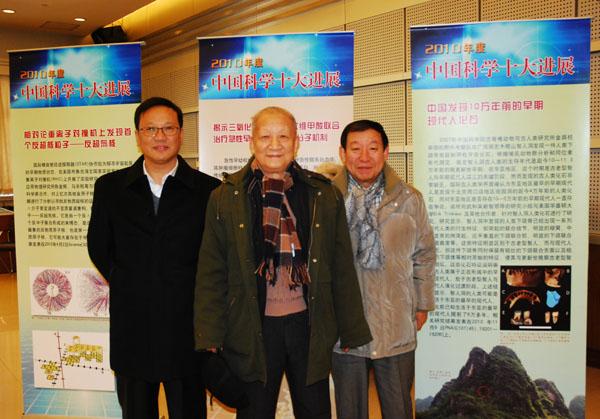China's Top Ten Science Achievements of 2010, conducted by The Supervising Center of Basic Research, Ministry of Science and Technology of China, released on Jan 18, 2011. One research discovery from Institute of Vertebrate Paleontology and Paleoanthropology (IVPP), Chinese Academy of Sciences, Human remains from Zhirendong, South China, and modern human emergence in East Asia , developed by Drs. LIU Wu, JIN Changzhu, ZHANG Yingqi, and their collaborators from China and North America, was honored as one of China's Top Ten Science Achievements of 2010.
The 2007 discovery of fragmentary human remains (two molarsand an anterior mandible) at Zhirendong (Zhiren Cave) in South China provides insight in the processes involved in the establishmentof modern humans in eastern Eurasia. The human remains are securely dated by U-series on overlying flowstones and a rich associated faunal sample to the initial Late Pleistocene, >100 kya. Therefore, they are the oldest modern human fossils in East Asia and predate by >60,000 y the oldest previously known modern human remains in the region.
The Zhiren 3 mandible in particular presents derived modern human anterior symphyseal morphology, with a projecting tuber symphyseos, distinct mental fossae, modest lateral tubercles, and a vertical symphysis; it is separate from any known late archaic human mandible. However, it also exhibits a lingual symphyseal morphology and corpus robustness that place it close to later Pleistocene archaic humans.
The age and morphology of the Zhiren Cave human remains support a modern human emergence scenario for East Asia involving dispersal with assimilation or populational continuity with gene flow. It also places the Late Pleistocene Asian emergence of modern humans in a pre-Upper Paleolithic context and raises issues concerning the long-term Late Pleistocene coexistence of late archaic and early modern humans across Eurasia.
"These fossils therefore support previous populational scenarios for the emergence of modern humans that include populational continuity (to whatever degree) and admixture in East Asia, a version of the Assimilation Model. They indicate that the appearance of modern human biology in portions of western and eastern Eurasia occurred in the early Late Pleistocene, long before the appearance of Upper Paleolithic (sensu lato) behavioral complexes.
They also further raise the question, long apparent for the western Old World, as to behavioral parameters underlying the apparent geographic separation of morphologically late archaic versus early modern human populations for tens of millennia, said Dr. WU Xinzhi, Institute of Vertebrate Paleontology and Paleoanthropology, Chinese Academy of Sciences.
"These fossils are helping to redefine our perceptions of modern human emergence in eastern Eurasia, and across the Old World more generally," says Eric Trinkaus, PhD, the Mary Tileston Hemenway Professor in Arts & Sciences and professor of physical anthropology.

Fig. 1. The human remains from Zhiren Cave. The Zhiren 3 mandible in anterior (A), lateral left (B), and superior (C) views. The midsymphyseal cross-section of the Zhiren 3 mandible (D). The Zhiren 1M3 in buccal and mesial views (E), and the Zhiren 2 M3 in the same views (F). (Scale bar, 5 cm.) (Image by Drs. LIU Wu and JIN Changzhu)

Related News
Photos
More>>trade
- The Second Joint Conference of Corruption Prevention: Adhering to the guidance
- Conclusion Ceremony of the Workshop on Corruption Prevention of Asian and
- He Yong Stressed at the National Experience Exchange Conference of Deepening
- He Guoqiang Stressed at the First Session of the Joint Conference of Corruption
- NBPC Office Holds a Special Lecture on UN Convention Against Corruption and its
market
- National Experience-Sharing Conference on Deepening Government Affairs Publicity
- The Second Conference of States Parties to the United Nations Convention against
- Representatives of the Workshop of Corruption Prevention for Asian and African
- The Workshop of Corruption Prevention for Asian and African Countries Came Back
- He Yong Met With Representatives of the Workshop of Corruption Prevention for
finance
- The Workshop of Corruption Prevention for Asian and African Countries Successful
- The First Phase of Special Discussion of the Workshop of Corruption Prevention
- Students of the Workshop of Civil Servants of Hong Kong Visited NBCP
- Fujian convenes working conference on corruption prevention
- National Roving Seminar on PCT Held in Xi'an





